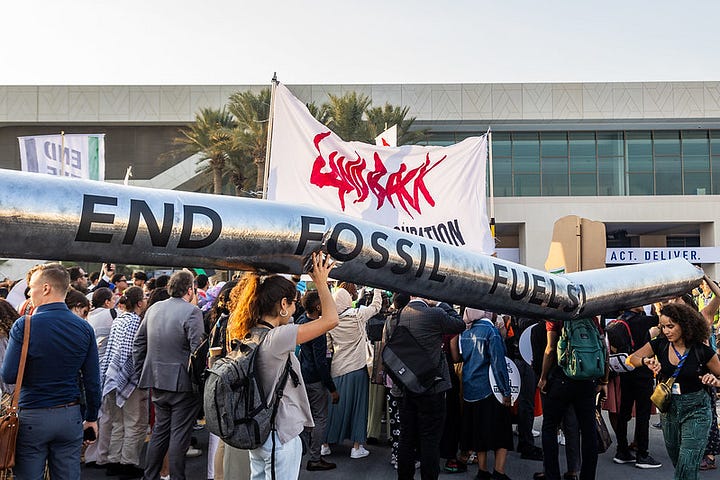On the Need For New Things—and its Opposite
A meditation on consumption, a rundown of COP28, and more.
Dear friends,
My mother read the entire Little House on the Prairie series out loud to me when I was between the ages of three and five. This was before my grandparents moved to Hawaii to live with us and brought a television. We had no indoor plumbing, no electricity, and we lived in a coffee shack my father had built using the wood he’d acquired tearing down an old sugar plantation house. We had a large garden and grew a lot of the food we ate. In other words, in those years, Laura Ingalls Wilder’s world was not entirely unlike my own.
And yet, years later, I think most often about Ingalls Wilder’s description of Pa coming home with a bolt of calico fabric, and the excitement she felt while donning a stiff, brand-new dress after wearing her old, worn dress for a year.
Growing up I received most of my new clothes in December and I think a lot about that new dress feeling this time of year, about what it means to replace something when you have thoroughly worn it out. I feel — like a slow hum under everything I do — how newness and oldness are two sides of the same coin. How you can’t truly inhabit new unless you are intimately acquainted with, and truly limited by, old.
I also think this time of year about the perfect object — that sparkly, unattainable kind of object we imagine we need and deserve as an antidote to the rest of what capitalism subjects us to.
How most of us have learned to live with the phantom of that object, even when we spend time resisting its power, or can’t afford or don’t have time to truly seek it out. How we sometimes believe we have found the perfect object, and how the feeling always passes.
Some perfect objects have utility. But at the core they are the negative space drawn around the shape of what we are not. We desire, we seek out, and we acquire such objects because we think they will buy us comfort, safety, and a screen behind which we can be our true, weird selves in privacy.
I am not free of these impulses! And yet I spend a lot of time thinking about how to live in this rapidly warming world glutted with imperfect objects. It is so filled with objects, in fact, that the objects have split into many tiny objects that have found their way into our own bloodstreams, into the bodies of the birds and animals we live beside while the manufacturing and shipping of ever more objects is causing the world to grow ever warmer.
So I wear used clothes, buy used things, drive an old car, and keep using my old phone with its cracked screen. I find that I can often do these things with a sense of purpose, even righteousness. But those feelings don’t last. Because all around us the experience associated with the old thing, that dress you wore for a year, is framed again and again— in ways blatant and incredibly subtle — as something to be ashamed of, as an unspoken kind of failure. (This isn’t a thing people consciously walk around thinking, but it undergirds many of our choices.)
The holiday season is the apex of all of this. This time of year, I watch anxiously as the Black Friday frenzy bleeds into December, as people talk about giving and receiving gifts or opting out of giving and receiving them. And I capitulate, I judge myself and others, I waffle. I close my eyes and try to get through it as quickly as possible without depriving my family of connection and joy.
I say all this because I want to give myself and you, my readers, permission to start chipping away at our cultural norms around consumption. Because it’s possible that together more of us can cultivate the parts of ourselves that will gladly go about wearing our old dresses until we have gotten absolutely everything from them. Until our clothes and our objects get out of our way and what’s left is just us, disentangled from all ideas of the perfect.
Climate News You May Have Missed
So many tipping points, so little time
2023 is now officially the hottest year in recorded history. All over the world, natural systems are reaching new limits and changing. Scientists call them “tipping systems.” Now, a group of 200 researchers from 26 countries have come together to publish a massive assessment of these systems—and the news is bleak, to say the least.
Five major systems are already at risk of crossing tipping points at the current levels of global warming: The Greenland and West Antarctic Ice Sheets, the North Atlantic subpolar gyre circulation, warm-water coral reefs and some permafrost regions. They added that Boreal forests, mangroves, and seagrass meadows are also at risk of tipping in the 2030s if the planet warms to 1.5°C above pre-industrial temperatures.
These tipping points could have a devastating impact on sea-level rise, changing weather patterns and reduced agricultural yields, which could then trigger larger social and political crises. As the researchrs write, “tipping elements are also not separate entities, they are closely linked: Triggering one tipping point in the Earth system or in human societies could in turn destabilize another tipping system, making tipping cascades possible."
Thankfully, the researchers also point to ways to enable “positive tipping points,” the kinds of wide-scale societal changes that need to happen if we’re going to avoid the kinds of cascades mentioned above. We can do that, they add, by “making the desired change the most affordable, attractive, convenient, accessible, or morally acceptable option.” And while that sounds like a tall order, it’s always worth mapping out that side of the equation, in my opinion.
COP28




The 28th United Nations Climate Change Conference (COP28) is arguably the most important one yet. And it has been a rollercoaster ride. Here’s my quick recap from afar.
A record number of people (90,000 at last count), including a flood of fossil fuel lobbyists, gathered in Dubai for two weeks to network, press the flesh, and sit through an ungodly number of panel discussions.
World leaders agreed to establish a loss and damage fund to help developing nations cover the cost of climate adaptation, then almost no one pledged to put any money in it.
A stalwart and vocal group of activists were corralled into a limited number of designated spaces and kept out of actual meetings (aside from 12-year-old Licypriya Kangujam, who made it into the room with global leaders on the penultimate day of the conference and was detained and reprimanded afterwards). Some of them used art in interesting ways.
When it looked like a fossil fuel phase out might finally be on the negotiating table, OPEC — the coalition of 13 oil producing countries that span Africa, Asia, the Middle East and South America — had a tantrum.
Several outspoken voices on climate weighed in. Bill McKibben reminded his readers the conference “is designed less to solve a crisis than to guard the interests of the world’s powers (both political and economic) as they relate to that crisis.” As if to prove his point, there was a session on responsible yachting.
George Monbiot, who has called COP28 “broken by design” also talked about the need to leave fossil fuels in the ground in a widely-shared video clip.
On Monday a draft of the document summarizing the agreement between nations (aka the Global Stocktake) was released without direct mention of a “fossil fuel phaseout.”
Many global leaders were outraged. The Alliance of Small Island States, responded by saying, “we will not sign our death certificate.” Leaders from 127 countries called for a phase out, up from 80 countries last year.
Al Gore said the talks were “on the verge of complete failure.”
Many leaders from the developing world pushed for the phase out language to be included, including John Kerry, despite abundant plans to do the complete opposite and continue developing oil and gas production in the Gulf of Mexico and elsewhere.
Some smaller nations opposed the phase out language because they worried they didn’t have the capital to transition to renewable energy as fast as developed world nations (many of whom have benefitted from oil and gas extraction) do.
Tense late-night negotiations ensued. Activists stayed put. The talked went into overtime.
On Wednesday morning, shortly after 6 am Dubai time, the COP28 leadership published an agreement that included a compromise: a sentence calling for "transitioning away from fossil fuels in energy systems, in a just, orderly and equitable manner." It’s an important step, but a far cry from what’s necessary if we’re going to prevent the planet from warming above the 1.5 C above pre-industrial levels. And, as my Civil Eats colleague Grey Moran noted, food system reforms were also essentially left out of the Global Stocktake.
On the Brighter Side
1. Paris has big plans to make its streets much more focused on bicycles and public transportation. As part of its new climate plan, the city is creating a large-scale Limited Traffic Zone (ZTL) in the heart of the city by the end of 2024.
2. Lawmakers in the state of Massachusetts have moved to begin phasing out natural gas and transitioning to electricity for heating and other similar purposes. At least 11 other states are exploring similar shifts.
3. Tribal-owned solar energy projects are bringing power, jobs, and economic opportunities to Native American communities. According to the BBC, “tribes have found that being sovereign nations — with the authority to self-govern — has meant they have been able to roll out renewables a lot faster than municipalities.”
4. E-bikes have had a great year. They have been outselling electric cars in the U.S. and also offsetting more gasoline.
5. The world’s largest beaver dam was discovered via satellite imagery 16 years ago, and only one person has seen it in person. I recommend this piece from Ian Frazier about the dam, the park it’s in, and the beavers’ resilience. He writes:
“Places almost impossible to get to undergird all of existence. In my car there are regions under the front seats where, when my cell phone falls into them, I must almost take the car apart to get it out. Beavers create hard-to-access places that are good for them, less so for us.”
Take care,
Twilight






I find fulfillment these days in visible mending. Saving loved items for beloveds is a joyful endeavor and stops the cycle for a bit longer.
My wife and I found that donations to charity make perfect gifts…especially for people who have so much stuff they wouldn't notice if we did gift something. Experiences (gift cards, tickets) are nice too, but then they have to use them. Donations are perfect: a great conversation starter, good even if the recipient ignores/misplaces/forgets about it, and no obligation to use/enjoy it.